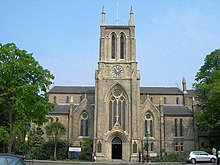| St James's Church, Norlands | |
|---|---|
 | |
 | |
| Location | St James's Gardens London W11 4RA |
| Country | England, United Kingdom |
| Denomination | Church of England |
| Churchmanship | Liberal Catholic[1] |
| Architecture | |
| Architect(s) | Lewis Vulliamy Robert Jewell Withers |
| Completed | 1845 |
| Administration | |
| Diocese | London |
| Deanery | Kensington |
| Parish | St Clement and St James |
Listed Building – Grade II | |
| Official name | Church of St James |
| Designated | 7 November 1984 |
| Reference no. | 1226520[2] |
St James' Church, Norlands, is a historic Grade II listed[1] church in London, United Kingdom. It is affiliated with the Church of England.[3] It was designed by architects Lewis Vulliamy and Robert Jewell Withers,[3] and its construction was completed in 1845.[1] The church was consecrated on 17 July of the same year.
The church is built of white Suffolk bricks and is orientated east to west with the tower positioned south of the central bay. The entrance is through a porch, built into base of the tower, facing down Addison Avenue. The simple body of the church makes the three-stage tower, built in 1850, stand out. The first stage has gabled Buttresses with roll-moulded edges. The second stage has a clock-face set in on each side and is considerably shorter than any other stage. The final belfry stage has two deeply-recessed paired lancets flanked by single blind lancet panels. There is a drawing in Kensington Public Library which shows that the tower was designed to have been topped with a broach spire, however, this was never built, and the tower seems somewhat abrupt and unfinished without it, as the thin octagonal pinnacles on each corner stand out against the sky.

Vulliamy's original design provided polygonal apsidal projections at the east and west ends, but these were never built. In 1876 the eastern end was extended by the architect, R. J. Withers. These extensions provide the present chancel, vestries and an organ chamber.[4]
The church is set in a small garden square, which is laid out in an informal style and is mainly two lawn areas with planting at the edges. The views are dominated by the mature chestnut and lime trees which surround the garden. These gardens are private and used by adjacent properties, and only open to the public occasionally.
- ^ a b c "St James: History". The Parish of St Clement and St James. Retrieved 13 May 2016.
- ^ Historic England (7 November 1984). "Church of St James (1226520)". National Heritage List for England. Retrieved 30 March 2024.
- ^ a b "St James, Holland Park". The Church of England. Retrieved 13 May 2016.
- ^ Sheppard, F H W, ed. (1973). "The Norland estate". Survey of London: Volume 37, Northern Kensington. London County Council (digital version via British History Online). pp. 276–297.